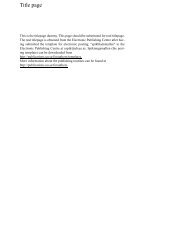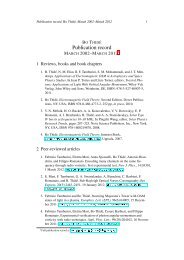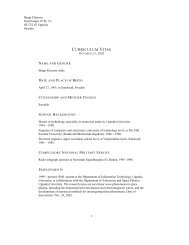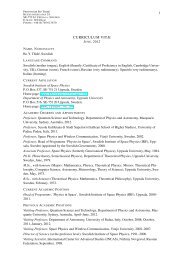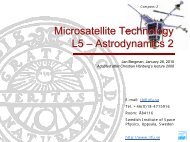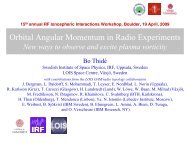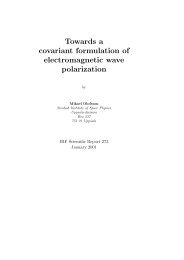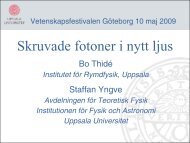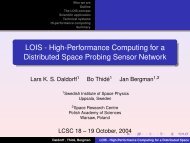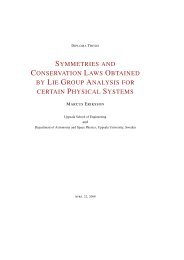Atmosphere-Ionosphere Mission - Swedish Institute of Space ...
Atmosphere-Ionosphere Mission - Swedish Institute of Space ...
Atmosphere-Ionosphere Mission - Swedish Institute of Space ...
You also want an ePaper? Increase the reach of your titles
YUMPU automatically turns print PDFs into web optimized ePapers that Google loves.
ORBITS AND PAYLOADS 21<br />
TABLE 2: Mass and power budget for the magnetic sensor and boom systems<br />
Mass<br />
E-field booms<br />
Magnetic sensor<br />
B-field boom<br />
Electronics box<br />
Power<br />
E-field<br />
B-field<br />
DPU<br />
0.25 kg/unit = 1 kg<br />
0.1 kg<br />
0.7 kg<br />
2 kg<br />
2 W<br />
2 W<br />
2 W<br />
poration and used in the SMART-1 spacecraft. The Danish <strong>Space</strong> Research <strong>Institute</strong><br />
is willing to provide a three-axis magnetic sensor-star camera combination.<br />
TABLE 3: The ∆n/n probe will be mounted on the extended magnetic boom<br />
Frequency range<br />
Power<br />
Probe bias<br />
Boom extension and probe<br />
0–10 kHz<br />
1 W<br />
±30 V<br />
0.1 kg<br />
For the HF radio measurements three orthogonal antennas (tripole vector sensor<br />
configuration) sensing the momentary (electric/magnetic) wave vector fields will<br />
be needed; see Table 1. The antenna currents are to be sampled digitally with at<br />
least 14 bit linear quantisation and the digital signals are then processed partially<br />
on-board and on the ground after being transferred over the telemetry. The processing<br />
will be made with the help <strong>of</strong> the advanced after-the-fact HF radio signal<br />
processing s<strong>of</strong>tware that has been developed and refined over nearly two decades<br />
at IRF Uppsala as part <strong>of</strong> the major digital HF radio receiver development work<br />
there over the same period <strong>of</strong> time.<br />
The boom and magnetic sensor systems are to be provided by KTH/RIT and<br />
DSRI and have the characteristics given in Table 2.<br />
The plasma turbulence will be measured with a Langmuir ∆n/n probe <strong>of</strong> the<br />
standard type developed in Uppsala and used in several missions. Data are given<br />
in Table 3.<br />
The Digital X-ray Imaging project (DIXI) detector which will be used as an<br />
imager, is described in technical terms in Table 4.<br />
<strong>Atmosphere</strong>-<strong>Ionosphere</strong> <strong>Mission</strong><br />
Elaborate Science Case



